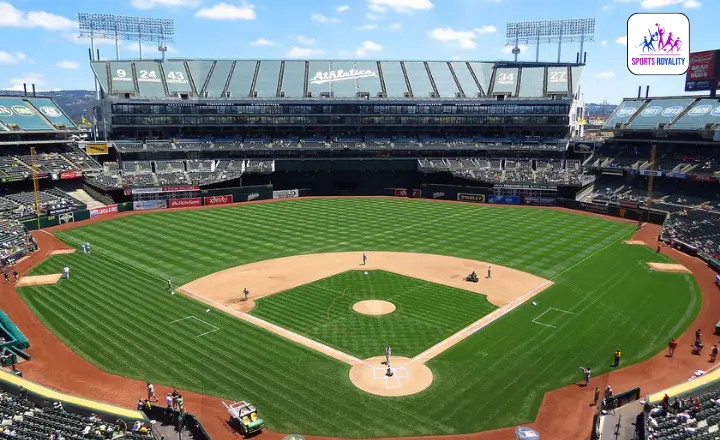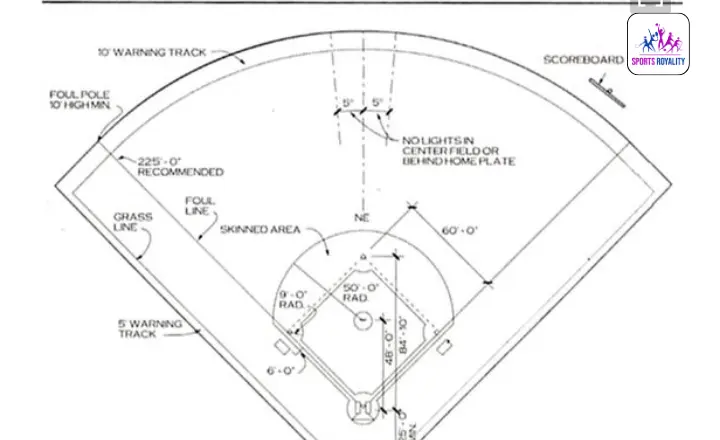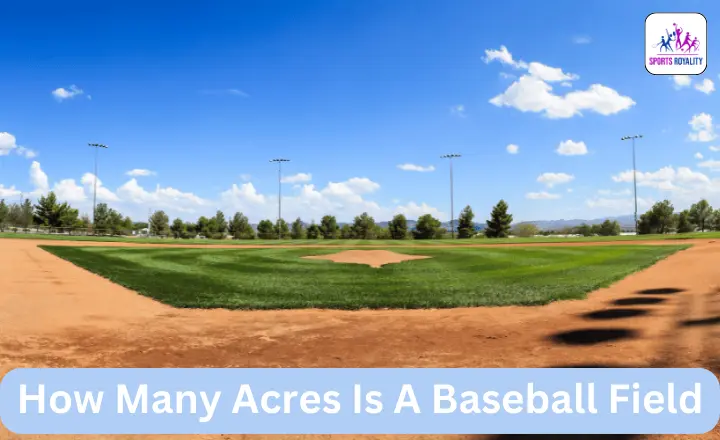It’s a warm summer evening, and you’re sitting in the stands at your local ballpark, eagerly awaiting the bat’s crack and the crowd’s roar. As you take in the sights and sounds around you, have you ever stopped to think about the incredible amount of land that goes into creating this magical space? Every inch is meticulously planned for maximum playability and spectator enjoyment, from foul pole to foul pole, pitcher’s mound to the outfield wall. But How Many Acres Is A Baseball Field does it take to make this dream a reality?
Join me on a journey as we dive deep into this question and explore exactly how much land is required for a baseball field.
Baseball Field Typical Space:
The dimensions of a baseball field can vary depending on the league, but a standard one typically covers approximately 3 acres of land. It means the field measures around 400 feet by 400 feet. A softball field is smaller, almost half the size of a typical baseball field.
Considering a standard baseball field with a 400-foot fence, the total area covered expands to about 4.5 acres. It’s worth noting that everything on the lot, from parking spaces to seating areas, is considered part of the baseball field.

When you step onto a baseball field, its sprawling expanse becomes evident. The open space stretches before you, inviting players and spectators to immerse themselves in the game. The generous dimensions allow players to demonstrate their skills by throwing precise pitches or hitting powerful home runs.
This vast area allows outfielders to chase down fly balls with agility while infielders showcase their defensive prowess in maneuvering within their designated positions. Baserunners traverse enormous distances between bases while pitchers fire fastballs from afar toward awaiting catchers.
How Many Square Feet?
It turns out that the average size of a baseball field is about three acres. That’s right. An entire baseball game is played on three measly acres.
So, how many square feet do these two sports share in overlapping playing areas? Below, I tell all measurements:
Baseball Field Typical Space Needs:
| Serial | Bases | Fences | Acres |
|---|---|---|---|
| 1 | 90′ | 400′ | 4.5 |
| 2 | 80′ | 315′ | 3.0 |
| 3 | 70′ | 275′ | 2.0 |
| 4 | 60′ | 215′ | 1.5 |
Softball Field Typical Space Needs:
| Serial | Bases | Fence | Acres |
|---|---|---|---|
| 1 | 65′ | 275′ | 2.5 |
| 2 | 60′ | 200′ | 1.5 |
On average, A ballpark is about 36,000 square feet, roughly three-quarters of an acre.
How To Measure A Baseball Field?
Measuring a baseball field accurately is crucial for both players and officials. Specific dimensions must be followed to ensure fairness and consistency in the game.
Here is some advice:
Backstop Trangulated:
You can start by measuring the distance from the home plate to the pitching rubber. It can be done by using a thread and noting its length. Repeat this process to ensure accuracy.
Once you have the measurement, mark the center of the backstop and draw a line from this point. Then, place the home plate at a predetermined distance from the backstop.
Measure a baseball field using a tape measure or measuring wheel. Start by measuring the distance from the home plate to each base, ensuring they are all equidistant. Then, measure the distance between the bases along the baselines, ensuring they are also equal in length.
Measure the outfield fence distance and any other relevant dimensions, such as foul lines or distances to specific landmarks on the field.
Second Base Location:
Locate the backstop’s center point by finding its midpoint. Then, measure an equal distance from this point towards both sides to determine where the second base should be placed.
Find the apex of the backstop by locating its highest point. It is usually at the center of the structure. Aligning the second base with this apex will help maintain symmetry on the field.
Aligning the second base with the pitcher’s mound involves measuring equal distances from both sides of the mound to determine where the second base should be placed. Ensuring that all three points are aligned correctly for a balanced playing field is important.
Position First And Third Bases:
Measure the distance from the third base to the baseline and draw an arc. Then, draw another arc from the middle of second to third base. Position the base to cross at the outer rear corner where the arcs intersect. Repeat this process to find the first base.
To measure the bases, measuring other key elements of a baseball field is important. This includes measuring the distance from the home plate to the outfield fence, typically around 400 feet for professional fields. The distance between bases is also important and should be measured accurately.
Set the Home Plate:
The back angles of the home plate should be aligned with the lines connecting the outer rear corners of the third and first bases to the peak. Once the home plate is set, you can measure other parts of the field.
Set Pitching Rubber:
Measure is the distance between the home plate and the pitching rubber. To ensure an even playing field, using a tape measure and finding the same distance at each corner of the home plate and pitching rubber is important.
It ensures a perfectly square field, creating equal opportunities for pitchers and batters. To determine the correct distance between the home plate and the pitching rubber, it’s necessary to consult official regulations.
Why Do Baseball Field Dimensions Vary?
The most intriguing aspect of baseball is the variation in field dimensions from one stadium to another. While some sports, like basketball or soccer, have standardized playing fields, baseball embraces uniqueness and diversity. Baseball field dimensions vary for several reasons, each bringing charm and challenges to the game.
Pitching Distances:
They are shorter for young players because it allows them to develop their skills and gradually increase their strength. Starting at 46 feet and gradually increasing to 60 feet and 6 inches in MLB ensures that hitters have enough time to react to the pitch.
Keeping the batter at a closer distance would make it nearly impossible for them to hit the ball. As players grow older and stronger, they are better equipped to handle pitches from a greater distance. Therefore, adjusting the pitching rubber length is crucial in maintaining a fair balance between pitcher’s and hitter’s positions.
While the length of the pitching rubber is important, a hitter’s response time plays a significant role in their ability to make contact with the ball. By varying baseball field dimensions, it allows for different play levels and ensure that pitchers and hitters have an equal opportunity to showcase their skills.
Routing Paths:
In Little League, the bases are set at a distance of 60 feet, which is suitable for young players. As they grow older and become more skilled, the base distance increases to 90 feet in high school and college baseball and 90-95 feet in professional baseball.
Home Run Fence:
The variation in home run fence dimensions is that many Little League grounds lack space for full-size fields. These smaller fields often have 200-foot fences, allowing young players to experience the joy of hitting a home run while providing enough room for defense and gameplay. This modified field size is ideal for youngsters just starting to learn and enjoy the sport.
Having accessible fences can benefit stronger hitters on these smaller fields. With shorter distances to clear, they have a greater chance of hitting home runs and showcasing their batting skills. This adds an extra layer of excitement and encourages young players to develop their hitting abilities and reach new levels in their game.

Final Words Of How Many Acres Is A Baseball Field
Understanding how many acres is a baseball field is essential for players, coaches, and enthusiasts alike. The size and layout of a baseball field can greatly impact the game and strategy involved.
Whether you are looking to build a new field or want to expand your knowledge of the sport, knowing the dimensions of a baseball field will provide valuable insights. Every square inch of a baseball field, from the outfield fence to the infield grass, shapes the game.
So, the next time you step onto the diamond, take a moment to appreciate the careful planning and design that goes into creating this iconic American pastime. Play ball!
FAQ’s:
How Many Innings Are In Baseball?
There are typically nine innings in a game. Each team gets a chance to bat and field for nine innings. In certain situations, such as tied games or extra innings, the game can extend beyond the initial nine innings.
Why Is A Baseball Field So Big?
Because it needs to accommodate a variety of playing abilities, baseball is a sport that requires players to run, throw, and hit the ball with precision. The field size allows players to showcase their skills in these areas.

